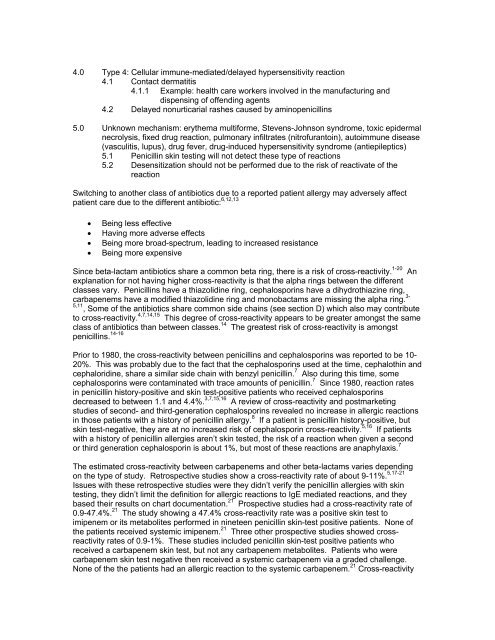Antimicrobial Use Guidelines (AMUG) version 21 - UW Health
Antimicrobial Use Guidelines (AMUG) version 21 - UW Health
Antimicrobial Use Guidelines (AMUG) version 21 - UW Health
You also want an ePaper? Increase the reach of your titles
YUMPU automatically turns print PDFs into web optimized ePapers that Google loves.
4.0 Type 4: Cellular immune-mediated/delayed hypersensitivity reaction4.1 Contact dermatitis4.1.1 Example: health care workers involved in the manufacturing anddispensing of offending agents4.2 Delayed nonurticarial rashes caused by aminopenicillins5.0 Unknown mechanism: erythema multiforme, Stevens-Johnson syndrome, toxic epidermalnecrolysis, fixed drug reaction, pulmonary infiltrates (nitrofurantoin), autoimmune disease(vasculitis, lupus), drug fever, drug-induced hypersensitivity syndrome (antiepileptics)5.1 Penicillin skin testing will not detect these type of reactions5.2 Desensitization should not be performed due to the risk of reactivate of thereactionSwitching to another class of antibiotics due to a reported patient allergy may adversely affectpatient care due to the different antibiotic: 6,12,13• Being less effective• Having more adverse effects• Being more broad-spectrum, leading to increased resistance• Being more expensiveSince beta-lactam antibiotics share a common beta ring, there is a risk of cross-reactivity. 1-20 Anexplanation for not having higher cross-reactivity is that the alpha rings between the differentclasses vary. Penicillins have a thiazolidine ring, cephalosporins have a dihydrothiazine ring,carbapenems have a modified thiazolidine ring and monobactams are missing the alpha ring. 3-5,11 , Some of the antibiotics share common side chains (see section D) which also may contributeto cross-reactivity. 4,7,14,15 This degree of cross-reactivity appears to be greater amongst the sameclass of antibiotics than between classes. 14 The greatest risk of cross-reactivity is amongstpenicillins. 14-16Prior to 1980, the cross-reactivity between penicillins and cephalosporins was reported to be 10-20%. This was probably due to the fact that the cephalosporins used at the time, cephalothin andcephaloridine, share a similar side chain with benzyl penicillin. 7 Also during this time, somecephalosporins were contaminated with trace amounts of penicillin. 7 Since 1980, reaction ratesin penicillin history-positive and skin test-positive patients who received cephalosporinsdecreased to between 1.1 and 4.4%. 3,7,15,16 A review of cross-reactivity and postmarketingstudies of second- and third-generation cephalosporins revealed no increase in allergic reactionsin those patients with a history of penicillin allergy. 8 If a patient is penicillin history-positive, butskin test-negative, they are at no increased risk of cephalosporin cross-reactivity. 5,16 If patientswith a history of penicillin allergies aren’t skin tested, the risk of a reaction when given a secondor third generation cephalosporin is about 1%, but most of these reactions are anaphylaxis. 7The estimated cross-reactivity between carbapenems and other beta-lactams varies dependingon the type of study. Retrospective studies show a cross-reactivity rate of about 9-11%. 5,17-<strong>21</strong>Issues with these retrospective studies were they didn’t verify the penicillin allergies with skintesting, they didn’t limit the definition for allergic reactions to IgE mediated reactions, and theybased their results on chart documentation. <strong>21</strong> Prospective studies had a cross-reactivity rate of0.9-47.4%. <strong>21</strong> The study showing a 47.4% cross-reactivity rate was a positive skin test toimipenem or its metabolites performed in nineteen penicillin skin-test positive patients. None ofthe patients received systemic imipenem. <strong>21</strong> Three other prospective studies showed crossreactivityrates of 0.9-1%. These studies included penicillin skin-test positive patients whoreceived a carbapenem skin test, but not any carbapenem metabolites. Patients who werecarbapenem skin test negative then received a systemic carbapenem via a graded challenge.None of the the patients had an allergic reaction to the systemic carbapenem. <strong>21</strong> Cross-reactivity
















